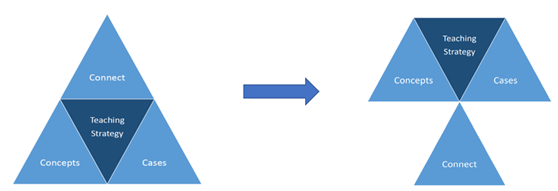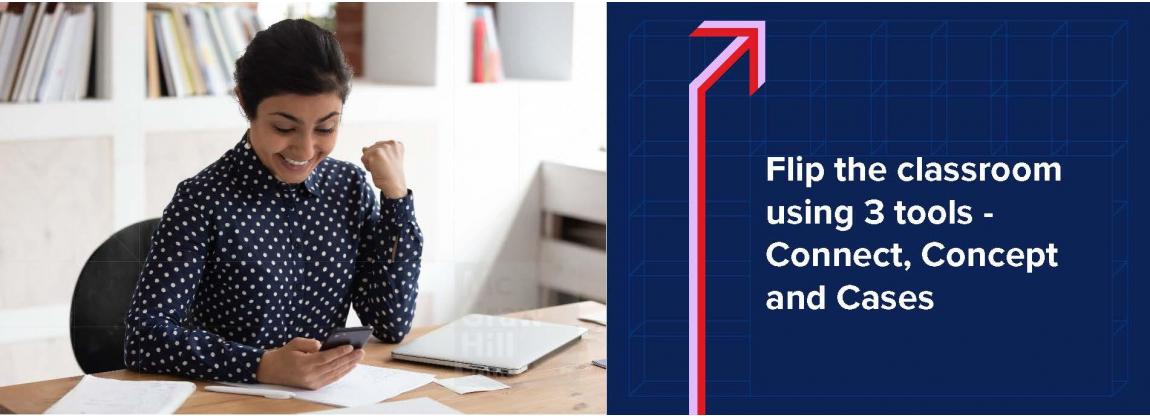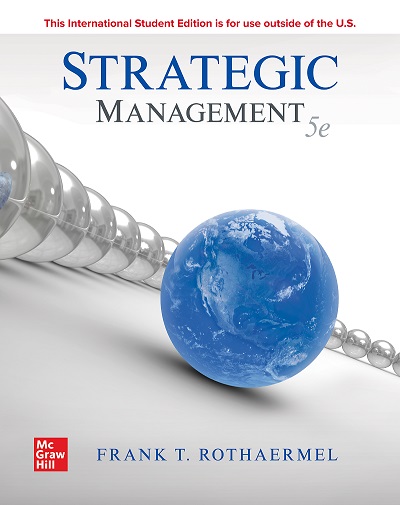Flip the Classroom using 3 tools: Connect, Concepts, and Cases
The typical way of disseminating knowledge in the education space involves experts in the field sharing their knowledge and learnings with their students. The pandemic dramatically changed the method of teaching from classroom setting to online. Everyone involved had to adapt to this change.
The COVID-19 pandemic illuminated a number of challenges instructors face:
- Pressure from stakeholders including students, parents, accreditation bodies and public policy as they want to understand the return on investment (ROI) on the money and student time spent.
- Higher performance demands on everyone involved including the instructors, universities and students.
- The attention span of students can be more fragmented because of the presence of the internet and other distractions, like social media. Their focus on reading books is believed by some to be relatively lesser.
- Building real-world skills in a remote setting is tough, as sometimes although students may know the strategy, they’re not always able to implement it.
- Competition from massive open online courses (MOOCs) pose active competition to the universities. Based on these challenges, some have opted to move their teaching model to a flipped classroom approach.
A big gap has been identified between knowing and doing i.e., a student may know about finance but can’t make smart decisions related to debt or equity financing using the cost of capital or a student may have studied operations but is unable to set up a supply chain or run a factory floor. This gap can be closed or minimised by flipping the classroom. One of the suggested methods is by introducing formative and summative assessments outside the classroom so that instructors can focus more on high value-added activities such as case discussions inside the classroom.
Flip the Classroom – What, Why and How
When the instructors integrate various concepts, frameworks, theories, and cases, and embed those in McGraw Hill Connect, they get an effective and strong teaching strategy - Concepts, Cases and Connect. And this can facilitate in flipping the classroom. This approach is applicable to a variety of courses.
By flipping the classroom, the students will acquire fundamental knowledge on their own prior to coming to the class. This will solve one of the biggest challenges of the instructors when unprepared students arriving in the class become a big hurdle to teaching. Flipping the classroom takes the burden of preparation off the instructors’ shoulders and lets them focus on higher value-add activities such as in-depth case discussions, critical thinking, decision-making under uncertainty with different options presented. This approach works well in different settings - online, hybrid, residential, in-person, or a combination of these.
Why - This approach is believed to be crucial for various reasons:
- The content is digital – It is available everywhere, across the globe, and always. It can be accessed by the students anytime, anywhere and on any device with or without the internet.
- Individualised and adaptive learning – Adaptive content allows students to learn at their own pace and meets them where they’re at. Learners enjoy the fact that they have the power to control and monitor the speed of their own learning. For example, students who are non-native speakers of English prefer to go through the content again later.
- Better engagement – Students come more prepared to the class and thus allow instructors to focus on more value-added discussions that elevate the teaching experience.
- Meet your students – It allows the instructors to meet the expectations of their students who are either Millennials or Generation Z and want fully digital content that’s accessible on any device.
How - Here are some ideas on how this can be achieved:
- In a residential environment, the instructor has the scope to improvise as the class moves on whereas, in an online or hybrid environment, the instructors need to spend dedicated time defining the structure of the class.
- Instructors need to establish an explicit learning contract with the students to set clear expectations. It is considered a good practice to set some expectations ahead of the term. Some professors prefer to grade students based on these criteria. 4Ps of student responsibilities - Preparation, Presence, Participation, and Professional behaviour.
- Instructors should make the technology work for themselves, be it a software or online platform. They must ensure that they are familiar with its functionalities well enough and technology problem doesn’t get attributed to many other challenges.
- Connect is used as an overall envelope to flip the classroom. Connect allows instructors to focus on an enhanced teaching time. It also enables them to shift their course fully online and then automatically deliver and execute it.

The 3Cs of Effective Teaching in an Online or Hybrid environment
- Connect is a course management and adaptive, individualised learning solution that allows instructors to focus on more value-added teaching.
- It contains the required readings (eBook and SmartBook), mini-cases, full-length cases, as well as quizzes.
- SmartBook is an adaptive reading experience available with Connect, that personalises content to meet the needs of each learner. It is an interactive and adaptive reading system that ensures that students understand the concepts and then dynamically adjusts the difficulty of the questions based on the students’ performance. Additionally, it sends students to remedial sections when they don’t perform well. SmartBook has received positive feedback from users across the globes and is considered as the second most popular application in Connect next to activity-based applications.
- Connect is accessible on multiple devices, online and offline.
Connect allows the instructors to save time, set up their courses prior to the semester, roll out the assignments automatically, and automatically grade them. Therefore, the instructor can focus more on value-added activities.
Concepts
A few assignments can be given to the students such as chapter readings, case studies and quizzes that need to be completed before the class and they all are setup within Connect. The instructor can then review the assignments prior to the class to get an idea on the students’ performance. This is one of the many ways how students’ understanding of the key concepts can be monitored by setting up regular assignments using Connect.
Instead of having one long exam, instructors can also conduct 10-12 smaller exams by setting up quizzes for each chapter at regular intervals. Live cases or simulations are useful for summative assignments while SmartBook can be used for formative assignments. The student scores can be seen on Connect and instructors can also allow multiple attempts for quizzes to ensure they go through the readings. Based on the results of students’ first attempt on questions, the instructor can identify topics where students need more practice and focus.
Activity based application (ABA) – These activities within Connect can help instructors to flip the classroom. These are mini simulations, interactive and auto-graded exercises. These provide students a safe space to practice, facilitate decision-making under uncertainty, apply problem-solving skills and acquire knowledge using realistic scenarios. Each scenario addresses key concepts and skills that students must use to solve course-specific problems. And this results in improved critical thinking and the building of relevant workplace skills.
Cases
There are different types of cases and preparation that can help instructors in an online or hybrid environment.
There are different types of cases that can be utilised - mini-cases, full-length cases, live cases, and case discussion questions that are given as a pre-class assignment
Instructors can also take some steps to help themselves prepare well, such as defining learning objectives, giving pre-class reading/assignment to the students within Connect, and providing regular updates to the students via different channels.
Conclusion
Concepts, Cases, and Connect are presented by Frank T. Rothaermel (a renowned researcher and prominent faculty in the US) as the 3Cs of effective teaching in an online or hybrid environment. Numerous benefits have been identified when instructors incorporate them in their teaching strategy.
- It enables flipping the classroom that can lead to an enhanced teaching experience.
- Facilitates full immersion of the instructor as expected by the students.
- Keeps students engaged by offering individualised adaptive learning and team learning to online/hybrid/residential or any mix of students across the globe.
- Allows data tracking that helps with accreditation and student assessment.
- Enables instructors to focus more on the value-added activities and help them prepare the students to build workplace skills.
All these together will help the instructors to close the gap between ‘knowing’ and ‘doing’ using a mix of summative and formative assignments.
The above content has been extracted from the webinar Creating an Effective Online Strategic Management Course, conducted by Frank T Rothaermel, where he shared his experience of using Connect for his course and how it enabled him to flip the classroom enhancing his teaching experience. For more information on the subject please watch the full webinar here
About the author
Frank T. Rothaermel is a Professor of Strategy & Innovation, with over 25 years of experience. He holds the Russell and Nancy McDonough Chair in the Scheller College of Business at the Georgia Institute of Technology, USA. He has taught a variety of courses including strategy, principles, microeconomics, business ethics, business & society, and entrepreneurship.
He is a renowned researcher and is named one of the ‘world’s most influential scientific minds by Thomson Reuters, having published papers in the top 1% based on citations. He is listed among the top 100 scholars based on impact over more than a. decade in both economics and business. Businessweek named Frank one of Georgia Tech’s Prominent Faculty in their national survey of business schools.
He is the author of McGraw Hill’s leading title, Strategic Management. He has written 58 cases (23 of them ‘bestsellers’) that are available on Harvard Business Publishing. He has received numerous awards for excellence in teaching and has taught Strategic Management to undergraduate, MBA and Ph.D. students. He is reachable at frank@ftrStrategy.com


